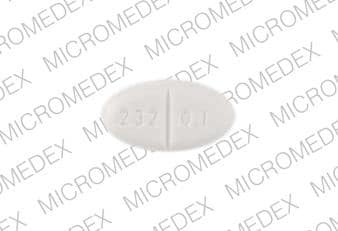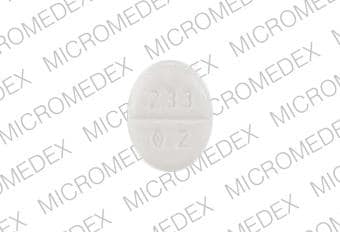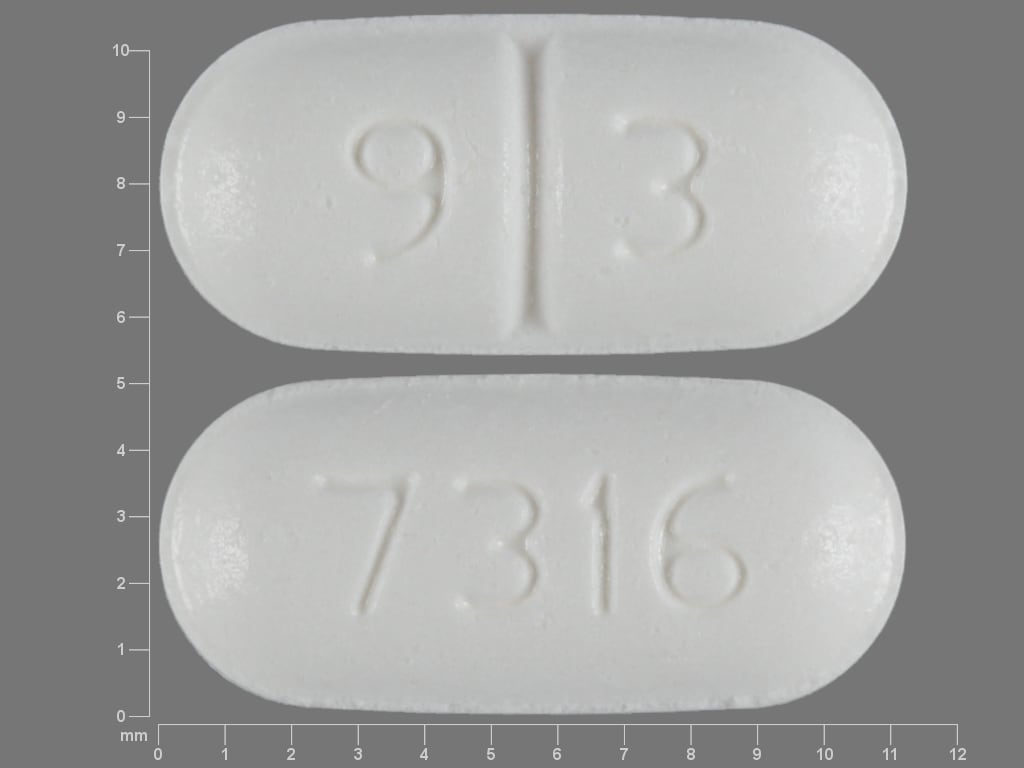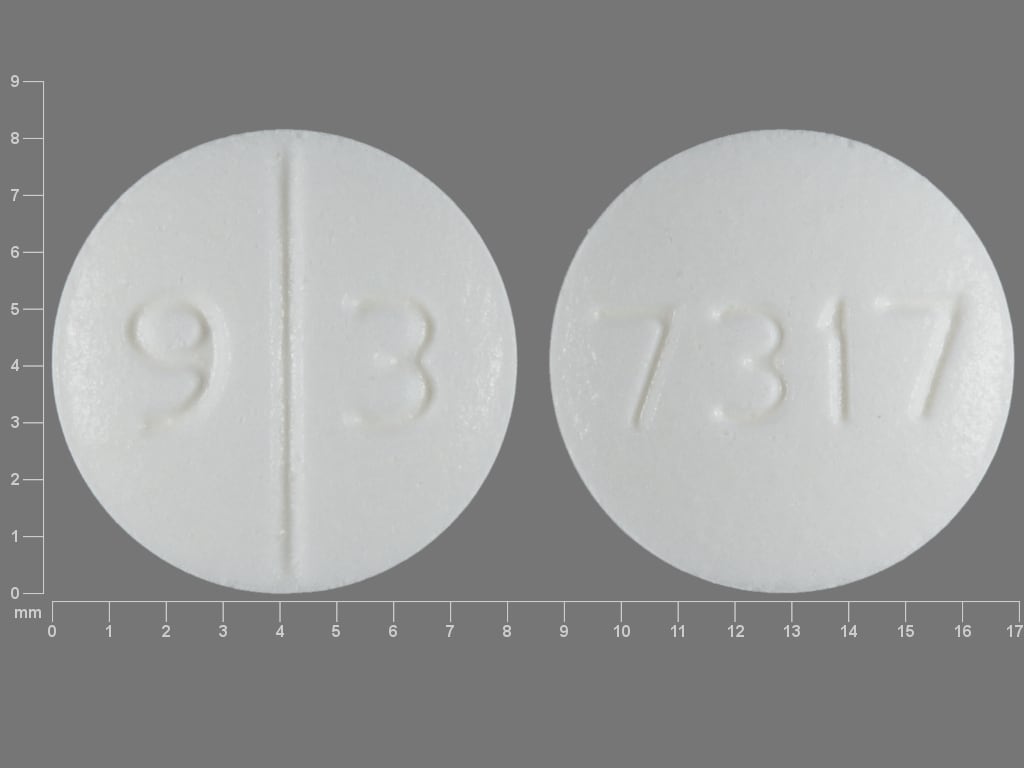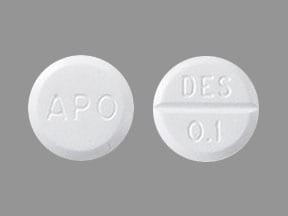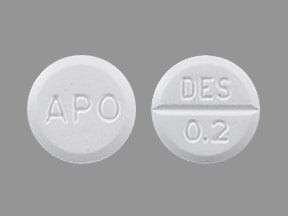Boxed Warning
Hyponatremia (Nocdurna, Noctiva nasal spray):
Desmopressin can cause hyponatremia. Severe hyponatremia can be life-threatening, leading to seizures, coma, respiratory arrest, or death. Desmopressin is contraindicated in patients at increased risk of severe hyponatremia, such as patients with excessive fluid intake, illnesses that can cause fluid or electrolyte imbalances, and in those using loop diuretics or systemic or inhaled glucocorticoids. Ensure serum sodium concentrations are normal before starting or resuming desmopressin. Measure serum sodium within 7 days and ~1 month after initiating therapy or increasing the dose and periodically during treatment. More frequently monitor serum sodium in patients ≥65 years of age and in patients at increased risk of hyponatremia. If hyponatremia occurs, desmopressin may need to be temporarily or permanently discontinued.
Dosage Forms
Excipient information presented when available (limited, particularly for generics); consult specific product labeling. [DSC] = Discontinued product
Emulsion, Nasal, as acetate:
Noctiva: 0.83 mcg/0.1 mL (3.8 g [DSC]); 1.66 mcg/0.1 mL (3.8 g)
Solution, Injection, as acetate:
DDAVP: 4 mcg/mL (1 mL)
DDAVP: 4 mcg/mL (10 mL) [contains chlorobutanol (chlorobutol)]
Generic: 4 mcg/mL (1 mL, 10 mL)
Solution, Injection, as acetate [preservative free]:
Generic: 4 mcg/mL (1 mL)
Solution, Nasal, as acetate:
DDAVP: 0.01% (5 mL) [contains benzalkonium chloride]
DDAVP Rhinal Tube: 0.01% (2.5 mL) [contains chlorobutanol (chlorobutol)]
Stimate: 1.5 mg/mL (2.5 mL) [contains benzalkonium chloride]
Generic: 0.01% (2.5 mL [DSC], 5 mL)
Tablet, Oral, as acetate:
DDAVP: 0.1 mg
DDAVP: 0.2 mg [scored]
Generic: 0.1 mg, 0.2 mg
Tablet Sublingual, Sublingual:
Nocdurna: 27.7 mcg, 55.3 mcg
Pharmacology
Mechanism of Action
Synthetic analogue of the antidiuretic hormone arginine vasopressin. In a dose dependent manner, desmopressin increases cyclic adenosine monophosphate (cAMP) in renal tubular cells which increases water permeability resulting in decreased urine volume and increased urine osmolality; increases plasma levels of von Willebrand factor, factor VIII, and t-PA contributing to a shortened activated partial thromboplastin time (aPTT) and bleeding time.
Pharmacokinetics/Pharmacodynamics
Absorption
Sublingual: Rapid
Metabolism
Unknown
Excretion
Urine (primarily)
Onset of Action
Intranasal: Antidiuretic: 15 to 30 minutes; Increased factor VIII and von Willebrand factor (vWF) activity (dose related): 30 minutes
Peak effect: Antidiuretic: 1 hour; Increased factor VIII and vWF activity: 1.5 hours; Nocturia: 0.25 to 0.75 hour
IV infusion: Increased factor VIII and vWF activity: 30 minutes (dose related)
Peak effect: 1.5 to 2 hours
Oral tablet: Antidiuretic: ~1 hour
Peak effect: 4 to 7 hours
Sublingual: Antidiuretic: ~30 minutes
Duration of Action
Intranasal, Injection, Oral tablet, Sublingual: ~6 to 14 hours
Half-Life Elimination
2 to 4 hours; Severe renal impairment: ~9 hours
Use in Specific Populations
Special Populations: Renal Function Impairment
AUC and T1/2 are ~3- to 4-fold higher in patients with eGFR <50 mL/minute/1.73 m2.
Use: Labeled Indications
Injection:
Diabetes insipidus: Antidiuretic replacement therapy in the management of central (cranial) diabetes insipidus; management of the temporary polyuria and polydipsia following head trauma or surgery in the pituitary region.
Limitations of use: Desmopressin is ineffective for the treatment of nephrogenic diabetes insipidus.
Hemophilia A: For use in patients with hemophilia A with factor VIII coagulant activity levels >5% to maintain hemostasis during surgical procedures and postoperatively when administered 30 minutes prior to the scheduled procedure and to also stop bleeding due to spontaneous or trauma-induced injuries, such as hemarthroses, intramuscular hematomas, or mucosal bleeding.
Limitations of use: Not indicated for the treatment of hemophilia A with factor VIII coagulant activity levels ≤5%, for the treatment of hemophilia B, or in patients who have factor VIII antibodies. In certain clinical situations, it may be justified to try desmopressin with careful monitoring in patients with factor VIII levels between 2% and 5%.
Von Willebrand disease (type 1): For use in patients with mild to moderate classic von Willebrand disease (type 1) with factor VIII coagulant activity levels >5% to maintain hemostasis during surgical procedures and postoperatively when administered 30 minutes prior to the scheduled procedure and to stop bleeding due to spontaneous or trauma-induced injuries, such as hemarthroses, intramuscular hematomas, or mucosal bleeding.
Limitations of use: Patients with von Willebrand disease who are least likely to respond are those with severe homozygous von Willebrand disease with factor VIII coagulant activity and factor VIII von Willebrand factor antigen levels <1%; other patients may respond (variable) depending on the type of molecular defect they have. Check bleeding time and factor VIII coagulant activity, ristocetin cofactor activity, and von Willebrand factor antigen during administration of desmopressin to ensure that adequate levels are being achieved. Not indicated for the treatment of severe classic von Willebrand disease (type I) or when there is evidence of an abnormal molecular form of factor VIII antigen.
Uremic bleeding (Octostim [Canadian product]): Prevention or treatment of bleeding in patients with uremia.
Intranasal:
Diabetes insipidus:
DDAVP Nasal Spray: Antidiuretic replacement therapy in the management of central diabetes insipidus in adults and children ≥4 years.
DDAVP Rhinal tube: Antidiuretic replacement therapy in the management of central diabetes insipidus; management of the temporary polyuria and polydipsia following head trauma or surgery in the pituitary region.
Limitation of use: Treatment of nephrogenic diabetes insipidus or primary nocturnal enuresis.
Hemophilia A (Stimate; Octostim [Canadian product]): For use in patients with hemophilia A with factor VIII coagulant activity levels >5% and to stop bleeding due to spontaneous or trauma-induced injuries, such as hemarthroses, intramuscular hematomas, or mucosal bleeding.
Limitations of use: Not indicated for the treatment of hemophilia A with factor VIII coagulant activity levels ≤5%, for the treatment of hemophilia B, or in patients who have factor VIII antibodies.
Nocturia (Noctiva): Treatment of nocturia due to nocturnal polyuria in adults who awaken at least 2 times per night to void.
Limitations of use: Has not been studied in patients <50 years of age.
von Willebrand disease (type 1) (Stimate; Octostim [Canadian product]): For use in patients with mild to moderate classic von Willebrand disease (type 1) with factor VIII coagulant activity levels >5% and to stop bleeding due to spontaneous or trauma-induced injuries, such as hemarthroses, intramuscular hematomas, mucosal bleeding, or menorrhagia.
Limitations of use: Not indicated for the treatment of severe classic von Willebrand disease (type 1) or when there is evidence of an abnormal molecular form of factor VIII antigen.
Oral:
Diabetes insipidus: Antidiuretic replacement therapy in the management of central diabetes insipidus; management of the temporary polyuria and polydipsia following head trauma or surgery in the pituitary region.
Limitation of use: Desmopressin is ineffective for the treatment of nephrogenic diabetes insipidus.
Nocturia (Nocdurna): Treatment of nocturia due to nocturnal polyuria in adults who awaken at least 2 times per night to void.
Primary nocturnal enuresis: Management of primary nocturnal enuresis, either alone or as an adjunct to behavioral conditioning or other nonpharmacologic intervention.
Use: Off Label
Hyponatremia (adjunct to hypertonic saline infusion to prevent overly rapid sodium correction)c
Data from a limited number of patients (case series) with severe hyponatremia (serum sodium <120 mEq/L) suggest that treatment with desmopressin as an adjunct to hypertonic saline may be beneficial for preventing overly rapid correction of hyponatremia MacMillan 2015, Sood 2013.
Note: Hyponatremia is listed as a contraindication for use of desmopressin in some instances. Use only in consultation with clinicians experienced in the management of hyponatremia. Dosing: Adult outlines appropriate patient selection.
Intracranial hemorrhage associated with certain antiplatelet agentsyes
Based on the Neurocritical Care Society and the Society of Critical Care Medicine guideline for reversal of antithrombotics in intracranial hemorrhage, desmopressin intravenous is suggested and may be considered in intracranial hemorrhage associated with certain antiplatelet agents (eg, aspirin, clopidogrel, prasugrel, ticlopidine, ticagrelor, cangrelor).
Surgical bleeding in patients with uremia (prevention)a
Data from a randomized, double-blind cross-over trial in patients with uremia, hemorrhagic tendencies, and prolonged bleeding times who were to undergo major surgery or renal biopsy supports the use of IV desmopressin for the prevention of bleeding in these patients Mannucci 1983.
Uremic bleeding associated with acute or chronic renal failurec
Data from a limited number of patients (case series) who were experiencing hemorrhage in the setting of renal insufficiency suggests that IV desmopressin may be beneficial for the treatment of this condition Watson 1984a. Additional data may be necessary to further define the role of desmopressin in the management of this condition. With the use of recombinant erythropoietin in patients with chronic renal failure, uremic bleeding is much less common than it was previously Mannucci 2007.
Contraindications
Known hypersensitivity to desmopressin or any component of the formulations; hyponatremia or a history of hyponatremia
Additional product specific contraindications:
DDAVP (injection, intranasal, oral): Moderate to severe renal impairment (CrCl <50 mL/minute)
Nocdurna, Noctiva: Renal impairment (eGFR <50 mL/minute/1.73 m2); polydipsia; primary nocturnal enuresis; concomitant use with loop diuretics or glucocorticoids (inhaled or systemic); syndrome of inappropriate antidiuretic hormone (SIADH) secretion (known or suspected); illnesses that may cause fluid or electrolyte imbalance (eg, gastroenteritis, salt-wasting nephropathies, systemic infection); heart failure (Noctiva labeling specifies NYHA Class II to IV); uncontrolled hypertension
Stimate: There are no contraindications listed in the Stimate prescribing information.
Canadian labeling: Additional contraindications (not in US labeling): Note: May not be applicable to all available dosage forms; refer to manufacturer labeling for further detail. Type 2B or platelet-type (pseudo) von Willebrand disease; habitual or psychogenic polydipsia, cardiac insufficiency or other conditions requiring diuretic therapy; nephrosis or any other condition associated with impaired water excretion, severe hepatic dysfunction; primary nocturnal enuresis; sodium losing conditions; SIADH secretion; lactose intolerance
Dosage and Administration
Dosing: Adult
Diabetes insipidus: Note: Fluid restriction should be observed. Dosing should be individualized to response.
IV, SubQ: US labeling: 2 to 4 mcg daily (0.5 to 1 mL) in 2 divided doses or one-tenth (1/10) of the maintenance intranasal dose. Fluid restriction should be observed.
IM, IV, SubQ: Canadian labeling (DDAVP Injection only): 1 to 4 mcg (0.25 to 1 mL) once daily or one-tenth (1/10) of the maintenance intranasal dose. Fluid restriction should be observed.
Intranasal (100 mcg/mL nasal solution): Usual dose range: 10 to 40 mcg daily (0.1 to 0.4 mL) as a single dose or divided 2 to 3 times daily; adjust morning and evening doses separately for an adequate diurnal rhythm of water turnover. Most adults require 10 mcg (0.1 mL) twice daily. Note: The nasal spray pump can only deliver doses of 10 mcg (0.1 mL) or multiples of 10 mcg (0.1 mL); if doses other than this are needed, the rhinal tube delivery system is preferred. Fluid restriction should be observed.
Conversion from injection to intranasal: Administer 10 times the amount of desmopressin acetate, rounded down to the nearest 10 mcg.
Conversion from oral to intranasal: Individual dose titration is required (intranasal desmopressin ~10- to 40-fold more potent than oral desmopressin).
Oral: Initial: 0.05 mg twice daily; total daily dose should be increased or decreased as needed to obtain adequate antidiuresis (range: 0.1 to 1.2 mg divided 2 to 3 times daily). Fluid restriction should be observed.
Sublingual formulation [Canadian product]: DDAVP Melt: Initial: 60 mcg 3 times daily; total daily dose should be increased or decreased as needed to obtain adequate antidiuresis. Usual maintenance: 120 to 720 mcg equally divided 2 or 3 times daily. Fluid restriction should be observed.
Hemophilia A and von Willebrand disease (type 1):
IV: 0.3 mcg/kg by slow infusion; may repeat dose if needed (based on clinical response and laboratory results); if used preoperatively, administer 30 minutes before procedure. A maximum IV dose of 20 mcg has been recommended (DDAVP injection Canadian product labeling).
SubQ: Octostim [Canadian product]: 0.3 mcg/kg; may repeat dose if needed (based on clinical response and laboratory results); if used preoperatively, administer 30 minutes before procedure
Intranasal (using high concentration spray [1.5 mg/mL]): <50 kg: 150 mcg (1 spray in a single nostril); ≥50 kg: 300 mcg (1 spray each nostril); repeat use is determined by the patient's clinical condition and laboratory work. If using preoperatively, administer 2 hours before surgery.
Hyponatremia (adjunct to hypertonic saline infusion to prevent overly rapid sodium correction) (off-label use): Note: Desmopressin should only be used as adjunctive therapy to hypertonic saline in patients with severe hyponatremia (<120 mEq/L) due to rapidly reversible causes (eg, hypovolemia) who are likely to develop water diuresis during the course of therapy or in those who are at high risk of osmotic demyelination syndrome. In these situations, desmopressin helps make serum sodium correction more predictable during hypertonic saline administration. Adjunctive desmopressin use is not recommended in patients whose cause of hyponatremia is not rapidly reversible (eg, edema due to heart failure or cirrhosis) or in patients with chronic syndrome of inappropriate antidiuretic hormone secretion (Sterns 2018).
IV, SubQ: 1 to 2 mcg every 6 to 8 hours for 24 to 48 hours or until serum sodium increases to ≥125 mEq/L (Sood 2013; Sterns 2018). Free water intake should be restricted during treatment. Experts recommend initiating desmopressin proactively (ie, at the beginning of treatment for hyponatremia) (Sterns 2018).
Intracranial hemorrhage associated with certain antiplatelet agents (aspirin, clopidogrel, prasugrel, ticlopidine, ticagrelor, cangrelor) (off-label use): IV: 0.4 mcg/kg once (NCS/SCCM [Frontera 2016]).
Nocturia:
Intranasal: Noctiva:
Not at risk for hyponatremia: 1.66 mcg in either nostril ~30 minutes before bedtime.
At risk for hyponatremia: Initial: 0.83 mcg in either nostril ~30 minutes before bedtime. After ≥7 days, may increase to 1.66 mcg if needed (provided the serum sodium is within the normal range during treatment with the 0.83 mcg dose). Note: The 0.83 mcg dose did not meet all prespecified efficacy endpoints in clinical trials but may have a lower risk of hyponatremia.
Sublingual: Nocdurna: Note: Dosage expressed as desmopressin acetate. Desmopressin acetate 27.7 mcg is equivalent to desmopressin (base) 25 mcg.
Females: 27.7 mcg once daily one hour before bedtime
Males: 55.3 mcg once daily one hour before bedtime
Primary nocturnal enuresis:
Oral: Initial: 0.2 mg at bedtime; dose may be titrated up to 0.6 mg to achieve desired response.
Sublingual formulation [Canadian product]: DDAVP Melt: Initial: 120 mcg administered 1 hour before bedtime; if bedwetting occurs after 3 days increase dose by 120 mcg/day. Dose may be further titrated up to a maximum of 360 mcg/day to achieve desired response. Treatment period is up to 3 months and then reassess with 1 week off treatment; if additional therapy is necessary, resume at same dosage prior to discontinuation.
Uremic bleeding: Octostim [Canadian product]: IV: 0.3 mcg/kg over 20 to 30 minutes (maximum dose: 20 mcg)
Uremic bleeding associated with acute or chronic renal failure (off-label use in US): IV: 0.4 mcg/kg over 10 minutes (Watson 1984)
Prevention of surgical bleeding in patients with uremia (off-label use in US): IV: 0.3 mcg/kg over 30 minutes (Mannucci 1983)
Dosing: Geriatric
Refer to adult dosing.
Nocturia: Avoid use (Beers Criteria [AGS 2019]).
Dosing: Pediatric
Note: Dosing presented is in mcg, mg, and mL (dependent upon product formulation); use extra precaution to verify product formulation and dosing units. Intranasal dosage forms have unique concentrations and indications for use and should not be used interchangeably; use in pediatric patients is contraindicated for some products (eg, Noctiva); consult product labeling.
Diabetes insipidus: Note: Fluid restriction should be observed in these patients; younger patients are more susceptible to plasma osmolality shifts and possible hyponatremia. Dosing should be individualized to response.
Oral: Children ≥4 years and Adolescents: Initial: 0.05 mg twice daily; titrate to desired response; optimal daily dose range: 0.1 to 0.8 mg/day in 2 to 3 divided doses; reported daily dose range: 0.1 to 1.2 mg/day
Intranasal:
DDAVP nasal spray (10 mcg/spray): Note: The nasal spray pump can only deliver fixed doses in 10 mcg (0.1 mL) increments; if doses other than this are needed, the rhinal tube delivery system is preferred.
Children ≥4 years and Adolescents: Initial: 10 mcg once daily into 1 nostril, may titrate dose up to 30 mcg/day in 1 to 2 divided doses; if administered twice daily, adjust morning and evening doses separately to provide for an adequate diurnal rhythm of urine output.
Rhinal tube (100 mcg/mL nasal solution):
Infants ≥3 months and Children: Initial: 5 mcg/day in 1 to 2 divided doses; usual range: 5 to 30 mcg/day in 1 to 2 divided doses; if administered twice daily, adjust morning and evening doses separately to provide for an adequate diurnal rhythm of urine output.
Adolescents: Usual range: 5 to 40 mcg/day in 1 to 3 divided doses; usual adult dose is 20 mcg/day in 2 divided doses; adjust morning and evening doses separately to provide for an adequate diurnal rhythm of urine output.
Parenteral:
Infants and Children <12 years: IV, SubQ: No definitive dosing available. Adult dosing should not be used in this age group; adverse events such as hyponatremia-induced seizures may occur. Dose should be reduced. Some have suggested an initial dosage range of 0.1 to 1 mcg in 1 or 2 divided doses (Cheetham 2002). Initiate at low dose and increase as necessary. Closely monitor serum sodium levels and urine output; fluid restriction is recommended.
Children ≥12 years and Adolescents: IV, SubQ: 2 to 4 mcg/day in 2 divided doses or one-tenth (1/10) of the maintenance intranasal dose; adjust morning and evening doses separately for an adequate diurnal rhythm of water turnover
Sublingual: Canadian labeling: DDAVP Melt [Canadian product]: Children and Adolescents: Sublingual: Initial: 60 mcg 3 times daily; total daily dose should be increased or decreased as needed to obtain adequate antidiuresis. Usual maintenance dose: 120 to 720 mcg in divided doses 2 to 3 times daily; divide daily doses so that the evening dose is 2 times higher than the morning or afternoon dose to ensure adequate antidiuresis during the night; fluid restriction should be observed.
Hemophilia A and von Willebrand disease (type 1; mild to moderate): Note: Adverse events such as hyponatremia-induced seizures have been reported especially in young children with IV use (Das 2005; Molnár 2005; Smith 1989; Thumfart 2005; Weinstein 1989). Fluid restriction and careful monitoring of serum sodium levels and urine output are necessary.
IV: Infants ≥3 months, Children, and Adolescents: 0.3 mcg/kg; if used preoperatively administer 30 minutes before procedure; may repeat dose if needed
Intranasal: High concentration spray 1.5 mg/mL: Infants ≥11 months, Children, and Adolescents:
<50 kg: 150 mcg (1 spray)
≥50 kg: 300 mcg (1 spray in each nostril)
Repeat use is determined by the patient's clinical condition and laboratory work; if using preoperatively, administer 2 hours before surgery
Subcutaneous: Canadian labeling: Octostim [Canadian product]: Infants ≥3 months, Children, and Adolescents: SubQ: 0.3 mcg/kg; if used preoperatively administer 30 minutes before procedure
Nocturnal enuresis: Note: Intranasal formulations are not recommended for nocturnal enuresis treatment.
Oral:
Children ≥6 years and Adolescents: Initial: 0.2 mg once before bedtime; titrate as needed to a maximum of 0.6 mg/day; fluid intake should be limited to a minimum from 1 hour before desmopressin administration until the next morning, or at least 8 hours after administration
Canadian labeling: Children ≥5 years and Adolescents: Initial: 0.2 mg once before bedtime; may titrate by 0.2 mg/day every 3 days as needed to a maximum dose of 0.6 mg/day; fluid intake should be limited to a minimum from 1 hour before desmopressin administration until the next morning, or at least 8 hours after administration. Treatment period is up to 3 months and then reassess with 1 week off treatment; if additional therapy is necessary, resume at same dosage prior to discontinuation.
Sublingual: Canadian labeling: DDAVP Melt [Canadian product]: Children ≥5 years and Adolescents: Sublingual: Initial: 120 mcg administered 1 hour before bedtime; may titrate by 120 mcg/day every 3 days as necessary to a maximum dose of 360 mcg/day to achieve desired response. Treatment period is up to 3 months and then reassess with 1 week off treatment; if additional therapy is necessary, resume at same dosage prior to discontinuation.
Reconstitution
DDAVP injection: Hemophilia A and von Willebrand disease (type 1): Dilute solution for injection in 50 mL NS for IV infusion.
Octostim injection [Canadian product]: Dilute solution for injection in 50 mL NS for IV infusion.
Administration
IM (Canadian labeling [DDAVP Injection only]; not in US labeling), IV push, SubQ injection: Central diabetes insipidus: Withdraw dose from ampul into appropriate syringe size (eg, insulin syringe). Further dilution is not required. Administer as direct injection.
IV infusion:
Hemophilia A, von Willebrand disease (type 1), and prevention of surgical bleeding in patients with uremia (off-label in US) (Mannucci 1983): Infuse over 15 to 30 minutes; Octostim [Canadian product]: Infuse over 20 to 30 minutes; infusion should not be <20 minutes. If used preoperatively, administer 30 minutes prior to procedure.
Acute uremic bleeding (off-label in US) (Watson 1984a): May infuse over 10 minutes
Uremic bleeding: Octostim [Canadian product]): Bleeding time should be normalized by administering a test dose once bleeding disorder is diagnosed or at least 72 hours prior to surgical procedures. Infuse over 20 to 30 minutes. When used pre-operatively administer 30 minutes prior to procedure.
Intranasal: Ensure that nasal passages are intact, clean, and free of obstruction prior to administration.
DDAVP: Nasal pump spray: Delivers 0.1 mL (10 mcg); for doses <10 mcg or for other doses which are not multiples, use rhinal tube. DDAVP Nasal spray delivers fifty 10 mcg doses. For 10 mcg dose, administer in one nostril. Any solution remaining after 50 doses should be discarded. Pump must be primed prior to first use by pressing down on pump 4 times; if pump not used for ≥1 week, re-prime by pressing down on pump once.
DDAVP Rhinal tube: Insert top of dropper into tube (arrow marked end) in downward position. Squeeze dropper until solution reaches desired calibration mark. Disconnect dropper. Grasp the tube 3/4 inch from the end and insert tube into nostril until the fingertips reach the nostril. Place opposite end of tube into the mouth (holding breath). Tilt head back and blow with a strong, short puff into the nostril. Reseal dropper after use.
Noctiva: Do not shake. Prime before using for the first time by pumping 5 actuations into the air away from the face. Re-prime by pumping 2 actuations into the air if the product has not been used for more than 3 days. Note: 2 sprays of 0.83 mcg/0.1 mL are not interchangeable with 1 spray of 1.66 mcg/0.1 mL; do not administer 2 sprays of the 0.83 mcg/0.1 mL product.
Octostim [Canadian product]: Gently blow nose to clear nasal passages. Prior to initial use, prime the pump by pressing down at least 5 times until an even spray appears. Spray is then ready for use. Dip tube inside bottle must always be submerged in the liquid when spraying. Tilt head back slightly and insert nasal applicator into one nostril. Hold breath as dose is administered. Repeat in opposite nostril if an additional spray is required. If used preoperatively, administer 2 hours prior to procedure. If spray pump is not used for 48 hours it must be primed again by pressing down a couple of times until an even spray appears. Pump will only deliver 150 mcg dose(s); if a different dose is needed, use the injection. Note: A test dose to measure response is recommended prior to initiating therapy.
Stimate: Press pump down 4 times to prime prior to initial use. Once ready, tilt pump, place nozzle tip in nostril, then spray. If pump has not been used for one week it must be primed again by pressing down once or until a fine mist is present. Discard after 25 sprays (excluding priming sprays). Note: A test dose to measure response is recommended prior to initiating therapy.
Oral, tablet:
May administer with or without food. Food may reduce/delay absorption although does not affect antidiuretic activity (Rittig 1998).
Diabetes insipidus: Fluid restriction should be observed.
Primary nocturnal enuresis: Minimize fluid intake beginning 1 hour prior to administration and continue until the morning (for at least 8 hours).
Sublingual:
Nocturia (Nocdurna): Tablet should be kept under the tongue until completely dissolved. Administer 1 hour prior to bedtime. Fluid intake should be limited 1 hour prior to dose until at least 8 hours after administration.
Primary nocturnal enuresis (DDAVP Melt [Canadian product]): Tablet should be kept under the tongue until completely dissolved. Fluid restriction should be observed. Minimize fluid intake beginning 1 hour prior to administration and continue until the morning (for at least 8 hours).
SubQ: Octostim [Canadian product]: May administer undiluted by direct injection.
Storage
DDAVP:
Nasal spray: Store at 20°C to 25°C (68°F to 77°F). Keep nasal spray in upright position.
Rhinal Tube solution: Store at 2°C to 8°C (36°F to 46°F). May store at 20°C to 25°C (68°F to 77°F) for up to 3 weeks.
Solution for injection: Store at 2°C to 8°C (36°F to 46°F).
Tablet: Store at 20°C to 25°C (68°F to 77°F). Avoid excessive heat. Protect from light.
DDAVP Melt [Canadian product]: Store at 15°C to 25°C (59°F to 77°F) in original container. Protect from moisture.
Nocdurna: Store at 20°C to 25°C (68°F to 77°F). Excursions permitted to 15°C to 30°C (59°F to 86°F). Protect from moisture and light.
Noctiva: Store at 2°C to 8°C (36°F to 46°F); excursions permitted between 0°C and 15°C (32°F and 59°F). Keep nasal spray in upright position. After opening, store at 20°C to 25°C (68°F to 77°F). Discard 60 days after opening.
Octostim [Canadian product]:
Nasal spray: Store at 15°C to 25°C (59°F to 77°F). Store in upright position. Do not freeze.
Solution for injection: Store at 2°C to 8°C (36°F to 46°F). Do not freeze. Following dilution in NS may store at room temperature for up to 24 hours.
Stimate nasal spray: Store at room temperature not to exceed 25°C (77°F). Discard 6 months after opening bottle. Store bottle in upright position.
Desmopressin Images
Drug Interactions
CarBAMazepine: May enhance the adverse/toxic effect of Desmopressin. Monitor therapy
ChlorproMAZINE: May enhance the adverse/toxic effect of Desmopressin. Monitor therapy
Corticosteroids (Nasal): May enhance the hyponatremic effect of Desmopressin. Avoid combination
Corticosteroids (Orally Inhaled): May enhance the hyponatremic effect of Desmopressin. Avoid combination
Corticosteroids (Systemic): May enhance the hyponatremic effect of Desmopressin. Avoid combination
Demeclocycline: May diminish the therapeutic effect of Desmopressin. Monitor therapy
LamoTRIgine: May enhance the adverse/toxic effect of Desmopressin. Monitor therapy
Lithium: May diminish the therapeutic effect of Desmopressin. Desmopressin may increase the serum concentration of Lithium. Monitor therapy
Loop Diuretics: May enhance the hyponatremic effect of Desmopressin. Avoid combination
Loperamide-Loperamide Oxide: May increase the serum concentration of Desmopressin. Monitor therapy
Nonsteroidal Anti-Inflammatory Agents: May enhance the adverse/toxic effect of Desmopressin. Monitor therapy
Opioid Agonists: May enhance the adverse/toxic effect of Desmopressin. Monitor therapy
Selective Serotonin Reuptake Inhibitors: May enhance the adverse/toxic effect of Desmopressin. Monitor therapy
Tolvaptan: May diminish the therapeutic effect of Desmopressin. Avoid combination
Tricyclic Antidepressants: May enhance the adverse/toxic effect of Desmopressin. Monitor therapy
Adverse Reactions
>10%:
Endocrine & metabolic: Hyponatremia (<1%; intranasal: 2% to 12%; sublingual: 3% to 4%)
Gastrointestinal: Xerostomia (sublingual: ≤14%)
1% to 10%:
Cardiovascular: Hypertension (intranasal: 2% to 3%)
Central nervous system: Headache (2% to 5%), dizziness (intranasal, sublingual: 2% to 3%), chills (intranasal: 2%), nostril pain (intranasal: 2%)
Gastrointestinal: Abdominal pain (intranasal: 2%), gastrointestinal disease (intranasal: 2%), nausea (intranasal: 2%)
Neuromuscular & skeletal: Asthenia (intranasal: 2%), back pain (intranasal: 1% to 2%)
Ophthalmic: Abnormal lacrimation (intranasal: 2%), conjunctivitis (intranasal: 2%), ocular edema (intranasal: 2%)
Respiratory: Rhinitis (intranasal: 3% to 8%), nasal discomfort (intranasal: 6%), nasopharyngitis (intranasal: 4%), nasal congestion (intranasal: ≤3%), epistaxis (intranasal: 2% to 3%), sneezing (intranasal: 2% to 3%), bronchitis (intranasal: 2%)
Frequency not defined:
Cardiovascular: Altered blood pressure, chest pain (intranasal), edema, facial flushing, flushing (intranasal), palpitations (intranasal), tachycardia (intranasal)
Central nervous system: Abnormality in thinking, agitation (intranasal), drowsiness (intranasal), insomnia (intranasal), localized warm feeling (intranasal), pain (intranasal)
Endocrine & metabolic: Weight gain
Gastrointestinal: Abdominal cramps, diarrhea, dyspepsia (intranasal), sore throat (intranasal), vomiting (intranasal)
Genitourinary: Balanitis (intranasal), vulvar pain
Hepatic: Increased serum aspartate aminotransferase (oral; transient)
Local: Burning sensation at injection site, erythema at injection site, swelling at injection site
Ophthalmic: Eye pruritus (intranasal), photophobia (intranasal)
Respiratory: Cough (intranasal), upper respiratory tract infection
<1%, postmarketing, and/or case reports: Anaphylaxis, atrial fibrillation, dysuria, serum hyposmolality, severe hypersensitivity, water intoxication
Warnings/Precautions
Concerns related to adverse effects:
- Allergic reactions: Severe allergic reactions have been reported with desmopressin; anaphylactic reactions have only occurred rarely with IV and intranasal administration.
- Fluid retention: May cause fluid retention, which can worsen underlying conditions susceptible to volume status. Use with caution in patients with heart failure; some products are specifically contraindicated in heart failure or uncontrolled hypertension. Some products are not recommended in patients at risk for increased intracranial pressure or those with a history of urinary retention.
- Hyponatremia: [US Boxed Warning]: Nocdurna, Noctiva: Desmopressin can cause hyponatremia. Severe hyponatremia can be life-threatening, leading to seizures, coma, respiratory arrest, or death. Desmopressin is contraindicated in patients at increased risk of severe hyponatremia, such as patients with excessive fluid intake, illnesses that can cause fluid or electrolyte imbalances, and in those using loop diuretics or systemic or inhaled glucocorticoids. Ensure serum sodium concentrations are normal before starting or resuming desmopressin. Measure serum sodium within 7 days and ~1 month after initiating therapy or increasing the dose and periodically during treatment. More frequently monitor serum sodium in patients ≥65 years of age and in patients at increased risk of hyponatremia. If hyponatremia occurs, desmopressin may need to be temporarily or permanently discontinued. Desmopressin use may rarely lead to hyponatremia with associated signs and symptoms (eg, confusion, decreased consciousness, depressed reflexes, disorientation, fatigue, hallucinations, headache, irritability, lethargy, loss of appetite, muscle weakness/spasms/cramps, nausea/vomiting, restlessness, weight gain) and extreme decreases in plasma osmolality, resulting in seizures, coma, respiratory arrest, and death. Other risk factors for hyponatremia with desmopressin use include cystic fibrosis, renal impairment, heart failure, young age, advanced age, inappropriate high fluid intake, a higher than recommended dose, and concomitant use of medications known to either increase thirst or cause syndrome of inappropriate antidiuretic hormone secretion (SIADH). Fluid restriction during use is recommended. Fluid intake in the evening and nighttime hours should be moderated to decrease the risk of hyponatremia. Monitor for signs/symptoms of hyponatremia; more frequent monitoring is recommended for patients on concomitant medications that increase the risk of hyponatremia (eg, TCAs, SSRIs, NSAIDs, chlorpromazine, carbamazepine, thiazide diuretics).
- Hypotension: Severe hypotension may occur with rapid IV infusions.
- Thrombotic events: Acute cerebrovascular thrombosis and acute myocardial infarction have occurred (rare) with desmopressin injection; use with caution in patients predisposed to thrombus formation.
Disease-related concerns:
- Cardiovascular disease: Injection and high-dose intranasal (used in hemophilia A and von Willebrand disease) desmopressin may cause a slight increase or transient decrease in blood pressure, and a compensatory increase in heart rate. Use with caution in patients with coronary artery insufficiency and/or hypertensive cardiovascular disease.
- Polydipsia (habitual or psychogenic): Use with caution in patients with habitual or psychogenic polydipsia. Patients consuming excessive amounts of water are at greater risk of hyponatremia. Products used for the treatment of nocturia are specifically contraindicated in patients with polydipsia.
- Primary nocturnal enuresis: When using desmopressin for primary nocturnal enuresis, treatment should be interrupted if the patient experiences an acute illness (eg, fever, recurrent vomiting or diarrhea), vigorous exercise, or any condition associated with an increase in water consumption to prevent hyponatremia. Products used for the treatment of nocturia are specifically contraindicated in patients with primary nocturnal enuresis.
- von Willebrand disease type 2B: Patients with type 2B von Willebrand disease requiring hemostasis should not be treated with desmopressin since may result in platelet aggregation, thrombocytopenia, and possibly thrombosis.
Special populations:
- Elderly: Fluid intake should be adjusted downward in the elderly to decrease the possibility of water intoxication and hyponatremia.
- Pediatric: Fluid intake should be adjusted downward in very young patients to decrease the possibility of water intoxication and hyponatremia.
Dosage form specific issues:
- Intranasal: Consider alternative route of administration if changes in the nasal mucosa (scarring, edema) occur leading to unreliable absorption. Some patients may demonstrate a change in response after long-term therapy (>6 months) characterized as decreased response or a shorter duration of response. Discontinue in patients with concurrent nasal conditions that may increase systemic absorption of desmopressin (eg, acute or chronic rhinitis, severe atrophic rhinitis, nasal blockage, nasal mucosal atrophy, recent nasal surgery); may resume desmopressin when conditions resolve.
- Tablet: Consider alternative route of administration (IV or intranasal) with inadequate therapeutic response at maximum recommended oral doses.
Monitoring Parameters
Blood pressure and pulse should be monitored during IV infusion
Note: For all indications, fluid intake, urine volume, and signs and symptoms of hyponatremia should be closely monitored especially in high-risk patient subgroups (eg, young children, elderly, patients with heart failure).
Diabetes insipidus: Urine specific gravity, plasma and urine osmolality, serum electrolytes
Hemophilia A: Factor VIII coagulant activity, factor VIII ristocetin cofactor activity, and factor VIII antigen levels, aPTT
von Willebrand disease: Factor VIII coagulant activity, factor VIII ristocetin cofactor activity, and factor VIII von Willebrand antigen levels, bleeding time
Nocturnal enuresis: Serum electrolytes if used for >7 days
Nocturia: Serum sodium concentrations at baseline, within 7 days, ~1 month after initiating/resuming therapy or increasing the dose, and periodically during therapy. More frequent monitoring in patients ≥65 years of age and those at increased risk of hyponatremia.
Uremic bleeding: Octostim [Canadian product]): Bleeding time before and 1 hour after IV infusion.
Pregnancy
Pregnancy Considerations
In vitro studies demonstrate poor placental transfer of desmopressin.
Desmopressin may be used throughout pregnancy for the treatment of diabetes insipidus (Aleksandrov 2010; Ananthakrishnan 2016; Brewster 2005; Schrier 2010). Information related to desmopressin for the treatment of von Willebrand disease in pregnancy is limited (NHLBI 2007); however, use is recommended for bleeding prophylaxis when otherwise indicated (Demers 2018; Pacheco 2010; Trigg 2012). Desmopressin is not recommended for nocturia caused by normal physiologic changes which occur during pregnancy.
Patient Education
What is this drug used for?
- It is used to help prevent bedwetting.
- It is used to treat a health problem called nocturnal polyuria that causes you to have to wake up at night to pass urine.
- It is used to treat diabetes insipidus.
- It is used to treat hemophilia.
- It is used to treat von Willebrand disease.
- It may be given to you for other reasons. Talk with the doctor.
Frequently reported side effects of this drug
- Flushing
- Dry mouth
- Abdominal cramps
- Stuffy nose
- Runny nose
- Common cold symptoms
- Back pain
- Cough
- Nosebleed
- Sore throat
Other side effects of this drug: Talk with your doctor right away if you have any of these signs of:
- Low sodium like headache, difficulty focusing, trouble with memory, confusion, weakness, seizures, or change in balance.
- Severe cerebrovascular disease like change in strength on one side is greater than the other, difficulty speaking or thinking, change in balance, or vision changes.
- DVT like edema, warmth, numbness, change in color, or pain in the extremities.
- Nausea
- Vomiting
- Sensing things that seem real but are not
- Loss of strength and energy
- Agitation
- Muscle weakness
- Muscle spasms
- Excessive weight gain
- Lack of appetite
- Shortness of breath
- Severe headache
- Severe dizziness
- Passing out
- Vision changes
- Swelling of arms or legs
- Chest pain
- Coughing up blood
- Fast heartbeat
- Abnormal heartbeat
- Injection site pain, edema, or irritation
- Signs of a significant reaction like wheezing; chest tightness; fever; itching; bad cough; blue skin color; seizures; or swelling of face, lips, tongue, or throat.
Note: This is not a comprehensive list of all side effects. Talk to your doctor if you have questions.
Consumer Information Use and Disclaimer: This information should not be used to decide whether or not to take this medicine or any other medicine. Only the healthcare provider has the knowledge and training to decide which medicines are right for a specific patient. This information does not endorse any medicine as safe, effective, or approved for treating any patient or health condition. This is only a brief summary of general information about this medicine. It does NOT include all information about the possible uses, directions, warnings, precautions, interactions, adverse effects, or risks that may apply to this medicine. This information is not specific medical advice and does not replace information you receive from the healthcare provider. You must talk with the healthcare provider for complete information about the risks and benefits of using this medicine.
